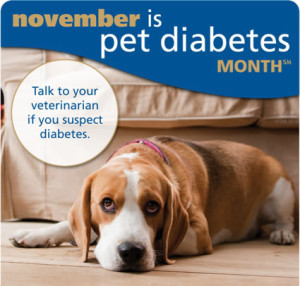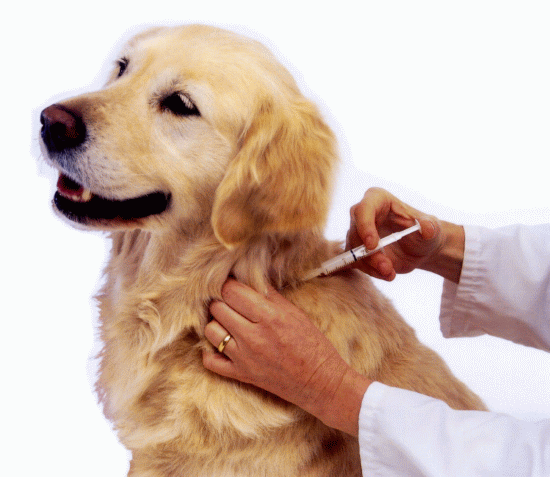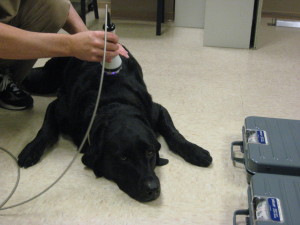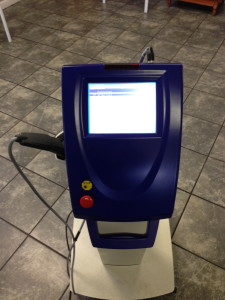Posts by Dr. Lelan Olsen
Chocolate Is Not For Everyone During The Holidays..
 Dogs are known for eating things when they are not supposed to. No responsible pet owner would ever intentionally feed their pup chocolate, but sometimes these furry scalawags sneak the forbidden snack right off the counter. This is especially true of puppies.
Dogs are known for eating things when they are not supposed to. No responsible pet owner would ever intentionally feed their pup chocolate, but sometimes these furry scalawags sneak the forbidden snack right off the counter. This is especially true of puppies.
Dogs have an excellent sense of smell, making it fairly easy to find any secret hiding spots for the chocolate. This can be a dangerous combination which could lead to a trip to your veterinarian—or worse the ER.
Chocolate is derived from the roasted seeds of the theobroma cacao, which contain certain properties that can be toxic to animals: caffeine and theobromine. If ingested, these two ingredients can also lead to various complications such as vomiting and diarrhea to rapid heart rates to coma, seizures and possible death.
A single piece of chocolate or a small amount will probably not be a problem because it doesn’t contain enough theobromine to harm your dog, however if your dog has eaten a whole box of chocolates, you need to call your veterinarian immediately. Do not wait.
When it comes to chocolate, it is imperative to remember this fact: Dark=dangerous! The darker the chocolate, the larger amount of theobromine it contains. Thus, baker’s chocolate, semi-sweet chocolate, cocoa powder and gourmet dark chocolates are more dangerous than milk chocolate and white chocolate has very little theobromine and will not cause chocolate poisoning in pets.
If your pet has ingested chocolate, it is important to induce vomiting and give multiple doses of activated charcoal to decontaminate . Aggressive IV fluids to help with the excretion of the toxin and sedatives to calm your pet and slow down the heart rate. The best treatment is to get your dog to your veterinarian immediately.
Of course, never consider chocolate as a reward. Always provide healthy treats or simply reward your dog with lots of love and attention. For more information, you can contact us via email or schedule an appointment if you think your furry friend has gotten a hold of some chocolate!
Signs Your Pet May Have Diabetes
 November has been designated Pet Diabetes Month to bring awareness to diabetes in our four-legged friends. Estimates vary, but it is believed that 2 percent and about 1 in every 160 dogs develops diabetes. Many owners are not aware that their dogs or cats can develop the disease or even what the symptoms of diabetes are among pets.
November has been designated Pet Diabetes Month to bring awareness to diabetes in our four-legged friends. Estimates vary, but it is believed that 2 percent and about 1 in every 160 dogs develops diabetes. Many owners are not aware that their dogs or cats can develop the disease or even what the symptoms of diabetes are among pets.
Diabetes has no cure, but can be managed successfully so that your cat or dog can live a full and happy life.
There are several clinical signs that may suggest that your pet is affected. These may include excessive water consumption, frequent urination, veracious appetite but does not gain weight, lethargy, cloudy eyes, or a dry, dull, or thinning hair coat.
When you bring your pet to the veterinarian, they will ask you about any signs or symptoms that you have noticed, how long they have been occurring, and which medications or supplements that your pet is taking. The veterinarian will also check your pet’s general health, determining if there are any infections or other conditions present.
Your veterinarian will check for glucose and ketones in the urine of your pet along with testing the glucose and fructosamine levels in your pet’s blood. Based on the tests, your veterinarian will then be able to set up a treatment protocol that may include insulin injections , diet change and regular exercise.
It is important that your pet’s needs be addressed, because diabetes can lead to kidney problems, nerve problems, and possibly eye problems. Up to 80 percent of the dogs who have diabetes can develop cataracts.
Diabetes is not just a human disease: your four-legged companions can develop the disease as well. With November being Pet Diabetes Month, it is a good time to learn about diabetes, be aware of the clinical signs, and make an appointment as soon as possible with your veterinarian if you observe any indications of the disease.
Pet Obesity Awareness – What You Need To Know
 Did you know what the most common nutrition related health condition in dogs is? It is obesity and tens of millions or about 40 percent of the dog population is affected. Fat pets have become the new norm and the sad thing is that most owners are unaware. The primary causes are like humans—being fed too much and not enough exercise.
Did you know what the most common nutrition related health condition in dogs is? It is obesity and tens of millions or about 40 percent of the dog population is affected. Fat pets have become the new norm and the sad thing is that most owners are unaware. The primary causes are like humans—being fed too much and not enough exercise.
The pet owners may notice layers of fat over their pets ribs, along the spine and around the tail. Your pet may have difficulty breathing and have a reduced exercise intolerance. There is a strong relationship in dogs between obesity and diabetes. The early signs of diabetes is the same as people-excessive thirst and urination. With obesity we see several medical problems that could be preventable. These include: heart disease, increased blood pressure, heat intolerance, joint damage and cancer. There can be an increased risk of complications during surgery. The research shows that your pets life can be shortened by 2 to 2 ½ years.
If you think that your pet has an obesity problem, seek your veterinarian’s advice. Because they are the expert in the field. Please don’t do it yourself because your pet’s nutrition and exercise program needs to be monitored closely. Especially in hot weather because of the stress on the heart and lungs.
When setting up a visit with your veterinarian, they will do a physical examination with blood tests. Ideally, the veterinarian will check the heart and lungs and check for signs of hormonal diseases such as hypothyroidism. They will then set up and ideal weight and send home some feeding and exercise guidelines. Initially, I recommend that a follow up visit be made for 4 to 6 weeks. It will probably take several months for your pet to reach its goal.
Pet owners must remember that it will take a family effort in getting everyone on board. It may work best to have only one family member in charge of feeding, but have everyone help exercise. Success can only happen by change, but it will bring healthy results. Which will bring a longer life for your pet.
Your veterinarian will probably recommend a reduced calorie diet. I would recommend that your pet also take a vitamin and mineral supplement to insure that the micro-nutrient and the essential fatty acids requirements are met. It may be good to give some fish oil to maintain good health.
It seems as owners that we tend to take the easy way out and reach into the cookie jar. In the end, living a life in which you prioritize healthy eating and exercise for all members of the family is the key. This means no more treats every time your dog does a trick. If you feel that they need a reward, give them praise and affection.
Join us as we recognize National Pet Obesity Awareness on Wednesday, October 9th this year, and help us prolong the life of your beloved companion.
The Truth About Rabies
 Rabies is a severe and often fatal disease that affects the gray matter of a dog’s brain and its central nervous system. Most generally, the rabies virus is transmitted to dogs through a bite from a diseased carrier like foxes, raccoons, bats, and skunks. Infectious virus particles are retained in a rabid animal’s salivary glands to better spread the virus through their saliva.
Rabies is a severe and often fatal disease that affects the gray matter of a dog’s brain and its central nervous system. Most generally, the rabies virus is transmitted to dogs through a bite from a diseased carrier like foxes, raccoons, bats, and skunks. Infectious virus particles are retained in a rabid animal’s salivary glands to better spread the virus through their saliva.
Once the virus enters the dog’s body, the virus replicates in the muscle and migrates to the nearest nerves. From there, the virus particles travel to the CNS via the fluid within the nerves. The symptoms can take up to a month to develop, but once they have begun, the virus progresses rapidly.
The inflammatory infection can be transmitted to humans, so this is of zoonotic importance.
Many people don’t realize that there are two forms of the disease. There is both a paralytic form and a furious form or a combination of the two. The furious form is the form that has the characteristic hyper-salivating and “mad dog” symptoms, but more times than not, the paralytic form or “dumb rabies” symptoms are present.
The paralytic forms clinical signs are characterized by weakness and loss of coordination, followed by paralysis.
The rabies virus is a fast moving virus, so if your pet is not treated soon after the symptoms appear, the prognosis is very poor. So, if your pet has been bitten by, been in a fight, or in contact with a rabid animal, it is my recommendation that you take your pet to your veterinarian for preventative care immediately
There are many symptoms to watch for in your pets. These include seizures, paralysis, difficulty swallowing, lack of muscular coordination, aggression and excessive excitability.
If you suspect that your pet has rabies, call your veterinarian immediately.
If your pet has been vaccinated, the pet will need to be quarantined for 10 days to monitor for changes in the pets behavior and possible progression of the rabies virus.
The only way to diagnose rabies is by a post-mortem antibody test. So if the pet is showing progressive signs of rabies, the animal will be euthanized and samples of the brain will be sent in to a diagnostic lab for confirmation.
There is no treatment for rabies, so most likely your pet will not survive the disease. Because people can also get rabies, it is of utmost importance that the pet gets prompt attention and the person that is exposed to rabies seeks medical attention immediately.
The Fallacies of Pets & Pet Health
 In my many years in the field of veterinary medicine, I have seen a tremendous number of dogs and cats presented for medical care. As one could imagine, the cases range from the simple and benign to the serious and life threatening. Throughout all of this, I’ve realized that certain problems seem to repeat themselves over and over again, and to be truthful, most problems are preventable with a little forethought, common sense, and knowledge in the proper areas. Thus I have composed a top ten list, if you will, of some of the more usual facts and fallacies that we face on a daily basis. These are in no particular order. I truly hope that you can benefit from them and therefore allow your pet to be happier and healthier from this point forward.
In my many years in the field of veterinary medicine, I have seen a tremendous number of dogs and cats presented for medical care. As one could imagine, the cases range from the simple and benign to the serious and life threatening. Throughout all of this, I’ve realized that certain problems seem to repeat themselves over and over again, and to be truthful, most problems are preventable with a little forethought, common sense, and knowledge in the proper areas. Thus I have composed a top ten list, if you will, of some of the more usual facts and fallacies that we face on a daily basis. These are in no particular order. I truly hope that you can benefit from them and therefore allow your pet to be happier and healthier from this point forward.
1. Pets are overweight because they eat too much. It is that simple. Obesity is the number one health problem today. This problem can cause numerous conditions that can rob your pet of both quality and quantity of life, such as heart and liver disease or musculoskeletal problems. You should be able to count each of your pet’s ribs. If you can’t, skip the denial and admit the problem. Enlist your veterinarian’s help as soon as possible. Your furry friend will thank you for it.
2. If your pet runs outside, be prepared for an expensive medical emergency or worse yet, the tragic loss of your pet. You wouldn’t turn your three-year old child loose on the street; why do you expect your pet to know any better? Automobiles, stray animals, poisons, and wild animals are just a few of the many ways your friend’s life could be cut short. Use common sense and keep your pet in the house, on a chain, or in a fenced yard.
3. If your pet has foul breath, it is probably from dental disease. Animals don’t brush and floss like humans, so infections can get started easily. Infections of the teeth can lead to heart, kidney, or even liver disease, along with the pain from chewing. If you note an odor or problems, please see your veterinarian.
4. All puppies and kittens should be started on their routine vaccinations no later than nine weeks of age, no matter what your friends and neighbors may have told you. Rabies vaccines can be given at 16 weeks, not 6 months as rumored. Follow the advice of your veterinarian to assure that your pet has a healthy and sufficient immune response.
5. Spaying and neutering your pet will prolong its life. All males not intended for breeding should be neutered at 5 to 8 months of age. All females not intended for breeding should be spayed at 5 to 8 months s, before her first heat cycle. The benefits ar2 indisputable and include the prevention of infections and numerous forms of cancer, as well as the obvious birth control effects. In addition, spaying and neutering do not make your pet fat and females do not need to have a litter to “calm them down.”
6. Just because you don’t see worms in your pet’s stool does not mean that there are no worms. Two of the most dangerous parasites, hookworms and whipworms, can only be detected in the egg stage under a microscope. Ideally your pet should be tested for intestinal parasites twice yearly. This is especially important if your pet is outside.
7. Most of your pet’s scratching is due to fleas and irritation from fleabites. We certainly see a lot of pets that have allergies to certain foods, plants, and molds, but the overwhelming winner when it comes to skin problems is the flea. The compound that makes fleas such a nuisance is actually the saliva they inject under the skin when they partake of a blood meal. Many folks are in disbelief when we tell them their pet has a flea allergy. As many as 70%of dogs and 40% of cats have this affliction. Consult your veterinarian as to how you can best deal with this common but controllable problem.
8. Dog food is for dogs, cat food is for cats and people food for people. We have seen cases every single day of gastrointestinal disturbances caused by the ingestion of food not normally found in the animal’s diet. The consequences range from simple diarrhea and vomiting to life threatening pancreatitis. Please use common sense and make table food a no-no. If your pet is a beggar, make him leave the room when you are eating. If your pet is a scavenger, make sure all trash cans are secure and the lids are locked.
9. If your pet develops diarrhea and/or vomiting for whatever reason, but is still playful and active, the first thing you want to do as a pet owner is take away the food and water. This should be done for at least 12 hours, and for vomiting, 24 hours. Ice cubes can be given to be licked on in lieu of water. The last thing a vomiting animal needs is a belly full of water; it will come back up and worsen the animal’s dehydration. After you have removed the food and water, please contact your veterinarian for further assistance.
10. When you have any questions about pet care or pet care products,contact your veterinarian. Don’t depend on the advice of friends, the pet store attendant, or the Internet.
Laser Therapy For Arthritic Dogs?
 Rex, a 135 pound German Shepherd has suffered from a limp and joint pain for the past two years. This man’s best friend, 70 in dog years, 10 in people years, needed treatment for his arthritic pain. But rather than opting for traditional pills or surgery, the owner tried a new, seemingly magical, laser therapy from the local veterinary clinic. After the procedure, Rex’s limp and overall activity and happiness improved almost immediately after the first laser treatment.
Rex, a 135 pound German Shepherd has suffered from a limp and joint pain for the past two years. This man’s best friend, 70 in dog years, 10 in people years, needed treatment for his arthritic pain. But rather than opting for traditional pills or surgery, the owner tried a new, seemingly magical, laser therapy from the local veterinary clinic. After the procedure, Rex’s limp and overall activity and happiness improved almost immediately after the first laser treatment.
Cold laser therapy is a noninvasive procedure that uses light to stimulate cell regeneration and increase blood circulation. Cold laser therapy treats the surface of the skin, while hot laser treatments affect deeper tissues. Cold laser therapy is still a relatively new concept that is being used more recently to treat dogs with arthritis, tendon, or soft tissue injuries and to promote wound healing.
The lasers are nothing more than a beam of light that travels at a certain frequency that allows the laser to generate heat and penetrate tissue. This process, know as photo-biotherapy stimulates protein synthesis and cell metabolism, which improves cell health and functionality. The procedure done at the correct wavelength, reduces pain signals and decreases nerve sensitivity. Endorphins are also released which are natural pain killlers.
Dogs find laser therapy relaxing and tend to enjoy the treatment, so there is no need for sedation or anesthesia. That means that treatment can be applied multiple times a day or a number of times per week. A typical laser therapy session can take as little as eight to ten minutes on a small dog or cat, or about a half hour for bigger dogs with more arthritic areas. There is no need to shave or clip the area to be treated.
If you have a dog with arthritis, you can expect to start laser treatment with two to three sessions per week, then decrease sessions to once a week, then once every two weeks. The number of therapy sessions are based on the response of the animal. If the arthritis is more advanced, then more sessions would be needed.
After laser therapy, pet owner’s might see their pet go upstairs more often, play with a ball he’s not picked up in months or go back to getting on the couch for his nightly snuggle with family members. And, when dogs have better mobility, medications can often be reduced. The cold lasers won’t cause any unwanted side effects and will not burn your pet’s skin. Cost generally only runs about $25 to $45 per session which is dependent on the length of the session.
Laser therapy improves the quality of a pet’s life as well as the life of its owner, because if your pet is happy, you are happy. Contact us for more information or to schedule an appointment!
June Is Adopt A Cat Month
 Is there anything sweeter than a kitten? Hmm…nope! Like any life decision, adopting a cat is a choice that should not be taken lightly. There are a number of things to consider, such as your own needs and expectations.
Is there anything sweeter than a kitten? Hmm…nope! Like any life decision, adopting a cat is a choice that should not be taken lightly. There are a number of things to consider, such as your own needs and expectations.
If you think you are ready for paw prints on countertops, cat fur on virtually everything and ready for litter box duty, be sure to consider the following before making a final decision. More goes into the kitten’s care than plopping down food and setting up a litter box.
1. Research Cats Before Adopting
It’s essential to spend time alone with any cat you’re adopting. You might do all your research and know exactly what you want, but if the cat you want doesn’t want you, there may be problems ahead. Getting to know each cat on a personal level before you make a choice can lead to a more positive adoption experience for all involved. You also may want to consider taking home two. Cats require exercise, mental stimulation, and social interaction. Two cats can provide this for each other. Plus they’ll provide more benefits to you. Cats’ purring has been shown to soothe humans as well as themselves–and they have an uncanny ability to just make you smile. A great place to start your search is online. Sites like Petfinder.com let you search numerous shelters in your are simultaneously to help narrow your search and more quickly find the match that’s right for you and your new feline friend.
2. Purr-sonality Matters
Just as we each have our own personality, so do cats. It is important to pick a cat that has a personality that will fit your needs. For example, if you’re looking for a lap cat, you’ll want to choose a cat or kitten that is comfortable being held and pet. If you want a cat that is playful, you’ll want to choose one that responds well to you and doesn’t slink away to nap in the corner. in general, cats with long hair and round heads and bodies are more easygoing than lean cats with narrow heads and short hair, who are typically more active.
3. Choose a Cat Whose Age Matches Your Lifestyle
Kittens may be cute, but they also require a lot of initial training and commitment, and need to be supervised to ensure they’re using the litter box, not clawing or chewing on household plants. Make sure you have the time to commit to training a kitten.
Adult cats are usually housebroken, have a routine of their own, normally don’t require the training that comes with a new kitten, and are usually not as demanding as their younger counterparts.

4. Ask About Overall Cat Health
You should always inquire as to the health of the pet you are thinking about adopting and if it has been spayed or neutered. You should check with the shelter staff about vaccinations and if there are any health issues you need to know about. Ask for a vaccination record at the time of adoption so you can show it to your veterinarian when your pet has its first examination.
5. Do See a Veterinarian ASAP
Kittens seem indestructible but get sick easily. A veterinarian’s early diagnosis improves the chances of a speed recovery. Screening tests and preventive care –vaccinations, flea prevention, worm medications –save lives and ensure your kitten grows to healthy adulthood. You will want to take any medical records you received from the adoption center along with your pet to your first visit so the veterinary staff can pet your cat and tell you that you’ve chosen the most beautiful cat ever.
Regardless of the cat you select, adopting isn’t like purchasing a household appliance or a piece of jewelry–this is a real living, breathing, and emotional being. So this means that you’re committing to her throughout her lifetime–which can mean up to twenty years in age or more.
Contact our office if you have more questions!
Microchips Are A Necessity – Does Your Pet Have One?
 Millions of pets become lost each year. In fact, 1 of 3 pets will go missing sometime in their lifetime. Tragically, few are reunited with their owners. The most recent information reports that only 15-20% of dogs and less than 2% of cats are ever reclaimed by their owners. One of the ways to increase the chances of finding your lost pet is having it microchipped. In Illinois, it is a state law that all pets must be microchipped.
Millions of pets become lost each year. In fact, 1 of 3 pets will go missing sometime in their lifetime. Tragically, few are reunited with their owners. The most recent information reports that only 15-20% of dogs and less than 2% of cats are ever reclaimed by their owners. One of the ways to increase the chances of finding your lost pet is having it microchipped. In Illinois, it is a state law that all pets must be microchipped.
A microchip is about the size of a grain of rice. It consists of a tiny computer chip housed in a type of glass made to be compatible with living tissue. The microchip is implanted between the pet’s shoulder blades under the skin with a needle and a special syringe. The process is similar to receiving routine vaccinations and most pets don’t even react when the microchip is implanted. Because the microchip is biocompatible, the pet shouldn’t experience any adverse reactions. The microchip provides a safe, permanent, and effective form of identification.
Microchips are read by a scanner that produces an electromagnetic field that energizes the microchip. The microchip is encoded with a unique identification number that is individual to your pet. Most shelters, veterinary offices, animals control offices, and police stations have access to the scanners.
The microchip is only as good as its registration, so registering your pet in a pet recovery database is the most important step in the microchipping process. Unfortunately, pet owners forget or don’t take the time or make the effort to register their pet. When an unregistered pet enters and animal control facility the pet could be adopted by another person or group, or the unthinkable could happen. Because unregistered pets are difficult to trace back to their owners these pets have a limited time to be reunited with their owners. Unclaimed pets take up unnecessary resources and cost taxpayers and donors an average of $120 in kennel fees. Remember, a microchipped pet has a better chance at being reunited with its owner but only if the pet is registered in a pet recovery database.
No method of identification is perfect and microchipping is not a GPS device. The best thing you can do is to protect your pet is to be a responsible pet owner. Keep current identification tags on your pets at all times, consider microchipping as reinforcement, and never allow your pet to roam free. If you dog does become lost, more identification can increase the odds of finding your beloved companion.
Preventing Tick-Borne Disease
 Ticks are a world-wide problem. They carry several diseases that can threaten the health of your dog. Such diseases include Ehrlichia, Anaplasma, Rocky Mountain Spotted Fever, and Lyme Disease. These diseases present us with different symptoms and most are difficult to diagnose in the early stages without aggressive diagnostic testing and prompt treatment. Depending on the disease, we can be presented with clinical signs that include lethargy, neurological deficits, deficiencies of all blood elements, high fever, arthritic pain, kidney failure, paralysis, and ultimately death. Early diagnosis and proper treatment is essential for positive outcomes.
Ticks are a world-wide problem. They carry several diseases that can threaten the health of your dog. Such diseases include Ehrlichia, Anaplasma, Rocky Mountain Spotted Fever, and Lyme Disease. These diseases present us with different symptoms and most are difficult to diagnose in the early stages without aggressive diagnostic testing and prompt treatment. Depending on the disease, we can be presented with clinical signs that include lethargy, neurological deficits, deficiencies of all blood elements, high fever, arthritic pain, kidney failure, paralysis, and ultimately death. Early diagnosis and proper treatment is essential for positive outcomes.
In order to prevent tick infestations, we must first understand the ticks environment and life cycle. Environmental prevention is based on what we know about the tick, which seems to be geared toward only two things, reproduction and survival, both of which depend on blood.
An adult female tick gets impregnated by a much smaller male and then engorges itself on the blood of an animal, it falls off and dies after laying a batch of eggs that may number in the thousands. The tiny, six-legged larvae that emerge from the eggs do not all survive, but the ones that do attach themselves for their first blood meal on small mammals like field mice. This is where the trouble can start for dogs if that mouse is a carrier-host for tick-borne disease since ticks are usually not born infected.
After feeding, the larvae molt, become nymphs and gain another pair of legs and the chance to become a carrier if the larger animal they feed on has a tick borne disease or pass infection on if they are already a vector from feeding on the small mammal.
Most ticks will climb on a grass blade or low-hanging tree branch and wait for your pet to come along, holding up their front legs in anticipation of grabbing hold. The ticks have chemoreceptors in sensory organs that act as taste buds on their front legs that they use to find their next meal. They know us by the carbon dioxide that the dogs and we breathe out, moisture, body heat and butyric acid which is a chemical that all mammals give off. So when a dog brushes by a tick, it will latch onto its fur and start looking for a place to attach and feed.
Not all ticks carry disease, but because of the numbers that exist makes sense to do everything possible to protect our dogs from being bitten. The way the tick behaves gives us clues how to keep the ticks away.
Obviously, since ticks like tall grasses and low-hanging tree limbs, it is best to cut the grass and remove the branches. It is also good to keep dogs away from areas where there could be small rodents such as stone walls and wood piles.
You can also spray the surroundings with a mild dish soap like Ivory with a garden sprayer. This detergent will also kill the honey bees, so do this in the evening when they are not around. Ticks do not like sulfur because of the pungent odor to their sensory organs.
There are several preventatives that are on the market that prevent ticks. Most of the good ones contain Amitraz. But do not use the products that contain Amitraz and permethrin on cats because they are toxic to them. Frontline Plus which is made by Merial contains Fipronil which is safe for cats.
The only tick-borne disease that has a vaccine available for prevention is Lyme disease. It works best in young dogs that have never been exposed before and must be given every year. Dogs have been known to get Lyme even though they have been vaccinated. Most veterinary teaching hospitals do not recommend it unless you live in an area where there is a strong likelihood of infection. The ease with which Lyme can be detected and treated may weigh against using the vaccine. Very rarely, dogs can have a reaction to the vaccine which leaves them with all the painful symptoms of Lyme disease but no hope of being cured as there is no disease to fight. Unfortunately, you cannot know if yours will be one of them before you vaccinate. However, many have been vaccinated and suffered no serious reaction and appear to be protected by the vaccine.
The best and safest way to remove a tick is to use a small curved Kelly forceps or a pair of tweezers or one of the tools especially made for the purpose, catch the tick right behind the flattened head as close as possible to the dog’s skin, and pull gently and straight out. Do not ever try to remove a tick with your fingers, burn it, put petrolatum jelly on it, twist it or jerk it. By grasping the tick with your fingers, you risk propelling the infectious saliva from the tick into your dog. After removing the tick drop it in a solution of water and dish soap to kill it.
Keep The Worms Out Of Your Pet’s Heart! The Facts About Heartworm Disease
 “Money can buy you a fine dog, but only love can make him wag his tail.” Kinky Friedman
“Money can buy you a fine dog, but only love can make him wag his tail.” Kinky Friedman
Heartworm disease is a serious disease that results in severe lung disease, heart failure, other organ damage, and death in pets, mainly dogs, cats and ferrets. It is caused by a worm-like parasite called Dirofilaria immitis that are spread from animal to animal from the bite of a mosquito. The adult heartworms live in the heart, lungs and associated blood vessels of an infected animal. The adult heartworms reproduce in the heart and produce microfilaria (immature heartworms) that are transported to other dogs from a mosquito bite. The microfilaria are in the mosquito for a short period of time and then spread to other pets by a bite from the mosquito. The microfilaria then mature, become adults and continue the life cycle.
Heartworm disease is not contagious to other dogs, so a dog cannot catch the disease from being near an infected dog. Heartworm disease is only spread through a bite from a mosquito.
In the United States, heartworm disease has been documented in each of the 50 states, but it is most common along the Atlantic and Gulf coasts from the Gulf of Mexico to New Jersey and along the Mississippi River and its major tributaries.
The most common test that a veterinarian uses to check for heartworms is an antigen test. This blood test detects for specific proteins, called antigens, which are released by the adult female heartworms into the dog’s bloodstream. This antigen test can accurately detect infections with one or more adult female heartworms that are at least seven or eight months old, but it doesn’t detect infections that are less than five months old.
Other tests are available to detect microfilariae in the dog’s bloodstream. Microfilariae in the bloodstream indicate that the dog is infected with adult heartworms. These adult heartworms are producing microfilariae that are circulating in the blood, so when they are found it has been at least 6 or 7 months since the dog was infected.
Dogs older than 6 or 7 months of age must be tested before starting on the heartworm preventitive. A dog may appear healthy on the outside, but on the inside the heartworms may be living and thriving. The heartworm preventitive does not kill the adult heartworms. Also giving the preventative can be harmful and deadly. If the microfilariae are in the bloodstream, the preventative may cause the microfilariae to die and cause a shock-like reaction and possibly cause death in some dogs.
The severity of the disease is directly related to the number of worms that are in the dog. The first clinical sign may be that your dog may tire a lot faster than normal. There may be a cough present with later signs being associated with trouble breathing and heart problems.
If your dog has heartworms, we can treat it. However, we must use an arsenic base product that is not easy on the dog or the owner’s pocketbook. The treatment can be potentially toxic to the dog’s body and can cause serious complications such as life-threatening blood clots to the dog’s lungs. The treatment is expensive and requires multiple visits to your veterinarian.
There are many FDA approved products on the market that prevent heartworm disease. They kill the microfilariae as they are injected into the bloodstream from the mosquito bites. They all require a prescription from your veterinarian. Most are either given orally or topically. Here at the clinic we require that the animal be tested first before we will dispense the heartworm prevention. It is best to keep your dog on preventative year round, but talk to your veterinarian to see what he thinks is best for your dog.

